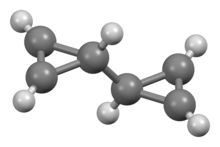Bicyclopropenyl

| |

| |
| Names | |
|---|---|
| Preferred IUPAC name
[1,1′-Bi(cyclopropane)]-1,1′-diene | |
| Other names
1,1′-Bi(cycloprop-2-en-1-yl)
3,3'-Bicyclopropenyl | |
| Identifiers | |
3D model (
JSmol ) |
|
| ChemSpider | |
PubChem CID
|
|
CompTox Dashboard (EPA)
|
|
| |
| |
| Properties | |
| C6H6 | |
| Molar mass | 78.1 g/mol |
| Melting point | −75 °C; −103 °F; 198 K |
Except where otherwise noted, data are given for materials in their standard state (at 25 °C [77 °F], 100 kPa).
| |
Bicyclopropenyl (bicycloprop-2-enyl, C6H6) is an organic compound and one of several valence isomers of benzene. The molecule can be described as two coupled cyclopropene units. The positions of the alkene groups can vary and therefore two other isomers are known: bicycloprop-1,2-enyl and bicyclopropen-1-yl.
The synthesis of all three isomers was reported in 1989 By Billups and Haley.
An
The other two isomers are increasingly unstable. Bicycloprop-1-enyl can only be detected in trapping experiments.
| Properties benzene valence isomers | ||
|---|---|---|
| Compound | Calc. | Calc. Heat of formation [4][5] |
| 0 K (KJ/mole) | 298 K (KJ/mole) | |
| Benzene | 100.5 | 82.0 |
| Dewar benzene | 415.5 | 397.1 |
| Benzvalene | 397.5 | 378.1 |
| Prismane | 567.2 | 547.0 |
| Bicycloprop-2-enyl | 593.6 | 578.8 |
Derivatives can be much more stable, for example perfluorohexamethylbicyclopropenyl that must be heated to 360 °C to be as unstable.[6]

